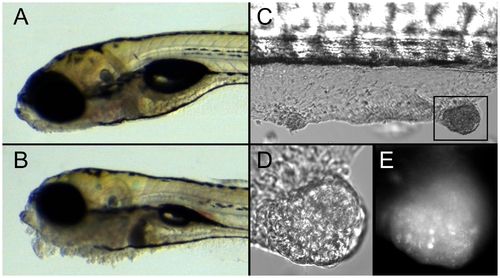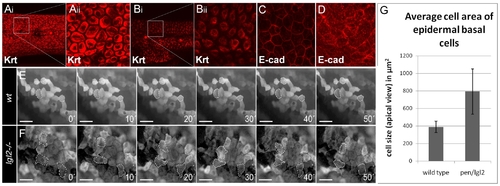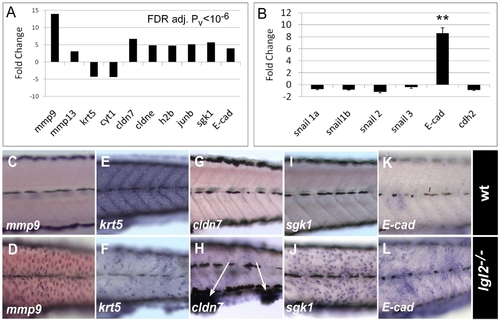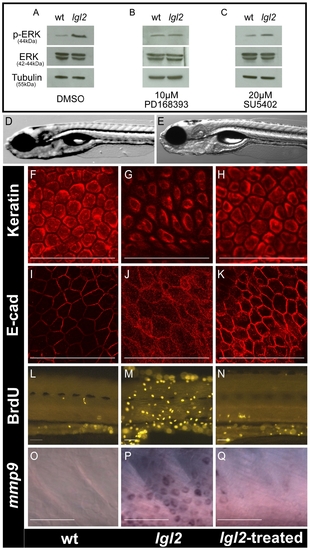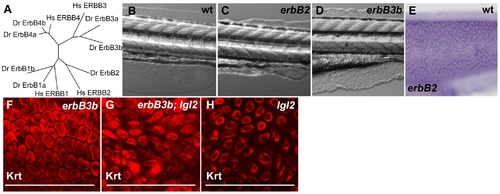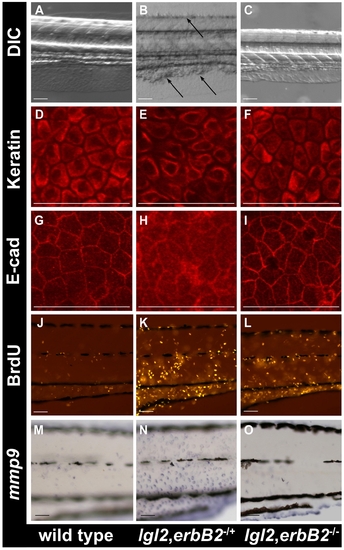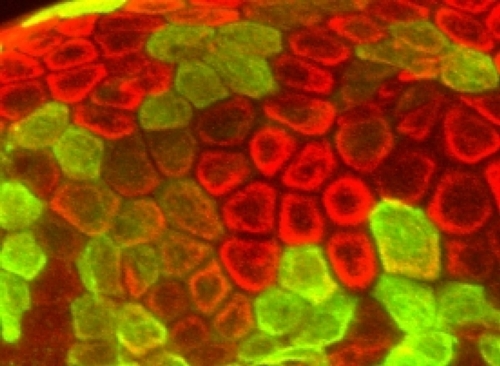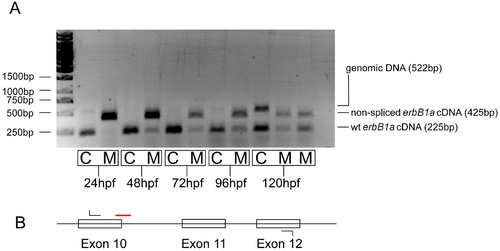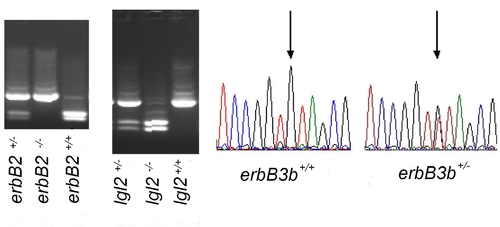- Title
-
Lgl2 executes its function as a tumor suppressor by regulating ErbB signaling in the zebrafish epidermis
- Authors
- Reischauer, S., Levesque, M.P., Nüsslein-Volhard, C., and Sonawane, M.
- Source
- Full text @ PLoS Genet.
|
pen/lgl2 deficient epidermal cells form tumors in a cell autonomous fashion. DIC images of 5-day-old wild-type (A) and pen/lgl2 mutant larvae (B). DIC image of wt host with pen/lgl2 mutant skin clones (C). Close-up of a tumor in DIC (D) and GFP channel (E). In comparison to 5 day wild-type larvae (A) the pen/lgl2 mutant larvae exhibit neoplasias, most prominently in the ventral jaw region (B). Seven days after the transplantation of pen/lgl2 mutant cells at blastula stage, recipients develop tumor like structures in the skin (C). These tumor like structures (D) contain GFP labelled cells (E) indicating that they are derived from mutant clones. PHENOTYPE:
|
|
Epidermal cells undergo EMT in pen/lgl2 mutant larvae. Basal epidermal cells of wild type and pen/lgl2 mutant 5dpf stained using pan 1?8 Cytokeratin antibody (Ai - Bii) and E-cad antibody (C, D). Time lapse analysis of tg(ΔNp63::Gal4,UAS::GFP) labelled cells in wild-type (E) and pen/lgl2 mutant larvae (F) at 5dpf. Analysis of cell area in wild-type and pen/lgl2 mutant larvae (G). In contrast to wild-type larvae (Ai, Aii), in pen/lgl2 mutant larvae the cells appear spindle shaped with keratin accumulation around the nucleus (Bi, Bii). Furthermore, in wild-type basal epidermal cells (C), E-cad localizes to the cell membrane; cells exhibit perfect polygonal shapes. In pen/lgl2 mutant larvae (D) membrane localization of E-cad is strongly reduced with concomitant increase in the cytoplasmic fraction. Time-lapse analysis reveals (E, F) that there is no change in the shapes of wild-type epidermal cells (E). However, in pen/lgl2 mutants (F) the shape of epidermal cells dramatically changes over time, indicating their metastable cell fate. Cells develop lamellipodia like structures, a classic trait exhibited by mesenchymal cell types (see Videos S1, S2, S3, S4 in addition). As epidermal basal cells flatten and develop lamellipodia like cell protrusions in pen/lgl2, the cell area in apical view is increased in these larvae (G). However, average area of epidermal basal cells in these mutants is highly variable compared to wild types. |
|
pen/lgl2 mutant epidermal cells differentially express EMT regulators. Graphical representation of expression data of some of the relevant genes obtained by microarray (A) and quantitative RT-PCR (B). RNA In situ hybridization analysis in wild-type (C, E, G, I, K) and pen/lgl2 mutant larvae (D, F, H, J, L) at 5dpf. Gene expression data obtained by microarray analysis reveals strong transcriptional activation of EMT associated matrix metalloproteinases like mmp9 and mmp13, cell-cycle related genes like proto-oncogene jun-b and histone 2b, whereas expression of cytokeratins like krt5 or cyt1 is decreased. Interestingly, tight junction proteins cldn7, cldne as well as adherens junction component E-cad and serum- and glucocorticoid-induced kinase-1 (sgk1) were also up-regulated in pen/lgl2 mutant. RT-PCR analysis (B) revealed that E-cad expression is indeed significantly up-regulated in mutant larvae with marginal decrease in snail expression levels. In situ hybridization analysis (C?L) reveals that the relevant genes are differentially expressed in the epidermis. Note that cldn7 is highly up-regulated in the cellular clumps in the finfold (arrows in H). ** = P<0.005 EXPRESSION / LABELING:
|
|
Inhibition of ErbB signaling restores the epidermal morphology and cell cycle in pen/lgl2 mutant larvae. Western blot analysis of Erk1/2 phosphorylation in untreated wild-type and pen/lgl2 larvae (A), larvae treated with PD168393 (B) and larvae treated with SU5402 (C). DIC images of wild-type (D) and pen/lgl2 mutant (E) treated with the ErbB inhibitor PD168393 and genotyped. The pan 1?8 cytokeratin antibody staining (F?H), anti E-cad staining (I?K), anti BrdU antibody staining (L?N) and in situ hybridization staining for mmp9 (O?Q) of the epidermis of wild-type (F, I, L, O) pen/lgl2 mutant (G, J, M, P) and mutant larvae treated with PD168393 (H, K, N, Q). In comparison to wild-type larvae (A, left lane, 44kD) Erk shows higher level of phosphorylation in pen/lgl2 mutant larvae (A, right lane 44kD). The levels of Erk phosphorylation are equal in the mutants treated with PD168393 (B) but not with SU5402 (C). The α-Tubulin levels (55kD) are indicative of equal protein loading. The epidermal cell morphology, E-cad localization, cell proliferation and mmp9 expression in pen/lgl2 larvae, treated with PD168393 (H, K, N, Q) appears similar to wild-type larvae (F, I, L, O) than the untreated mutant larvae (G, J, M, P). Note that PD168393 treated (rescued) larvae were genotyped to confirm their genotypes. EXPRESSION / LABELING:
|
|
Phylogenetic analysis of erbB family members and zebrafish mutants of erbB paralogs. (A) Phylogenetic analysis of erbB family members in the zebrafish genome (zv7) with the human orthologs (Minimum evolution algorithm, 100 replicates). With the exception of erbB2, all other erbB family members are duplicated in zebrafish. (B?D) DIC Images of wild-type (B), erbB2-/- (C) and erbB3b-/- (D) larvae at 132hpf. (E) In-situ hybridization analysis of erbB2 at 48hpf. Keratin staining in erbB3b mutant larva (F) erbB3b/lgl2 double mutant larva (G) and pen/lgl2 mutant larva (H) at 132 hpf. Note that in erbB3B;lgl2 double mutants (G) epidermal cells appear spindle shaped as in pen/lgl2 mutant larvae (H). erbB3b (F) mutations alone do not affect the morphology of basal epidermal cells. |
|
erbB2 promotes EMT in the epidermis of pen/lgl2 mutant larvae. DIC images of the morphology of wild-type (A), lgl2,erbB2+/- (B) and lgl2,erbB2-/- (C) larvae at 108hpf. Keratin (D?F), E-cadherin (G?I), BrdU (J?L) and mmp9 (M?O) staining in wild-type (D, G, J, M), lgl2,erbB2+/- (E, H, K, N) and lgl2,erbB2-/-(F, I, L, O) larvae at 108hpf. The DIC images of the morphology reveals that cellular clumps, a typical characteristic of pen/lgl2 mutant larvae are present in lgl2,erbB2+/- (B) but are absent in lgl2,erbB2-/-(C). The keratin, E-cadherin and mmp9 staining in lgl2,erbB2-/- (F, I, O) appear similar to wild-type (D, G, M) indicating erbb2 promotes the EMT phenotype in pen/lgl2 mutant larvae. Note that, in lgl2,erbB2-/- larvae (L) BrdU incorporation does not decrease to wild-type levels (J). |
|
Expression of GFP under the ΔNp63 promoter. Antibody staining of 5.5dpf tg(ΔNp63::Gal4,UAS::GFP) zebrafish larvae using anti Cytokeratin (red) and anti GFP antibody (green). The co-labeling of both antibodies reveals activity of the 4.96 kb upstream promoter element of ΔNp63 exclusively in basal epidermal cells in the skin. |
|
Knockdown of erbB1a using morpholinos. For knock-down of erbB1a, we used a morpholino targeted to a splice site. To test the activity of this morpholino over time, primers spanning the targeted intron-exon boundary were designed. (A) PCR performed on cDNA from morphant zebrafish larvae at different time points reveals morpholino efficiency. (B) A working morpholino causes splice events to fail at the targeted splice site (red) resulting in larger PCR product. Genomic DNA contamination of the cDNA causes a third, larger, product as the amplicon spans two introns on the genomic template. This analysis reveals that the used morpholino only prevents efficient splicing of erbB1a RNA before 48hpf, causing equal amounts of spliced vs. morphant RNA at later stages. Primers used for PCR: 5′-CCACCAACA TCGACTCCTTT-3′; 5′-AAACCTTGAGGTCATCCGAG-3′. Morpholino sequence: 5′-AAATGCTCTTCCTCACCCTCTGAAT-3′. |
|
Genotyping of lgl2, erbB2, and erbB3b. The genotype of larvae presented in this work was scored using PCR-based restriction fragment length polymorphisms (RFLP) for erbB2 and lgl2 or by sequencing for erbB3b. The mutation in lgl2 causes an artificial restriction site for SfcI. The mutation in erbB2 causes a loss of a BsrGI restriction site. Treatment of PCR products from individual genomic samples with either SfcI or BsrGI leads to a genotype specific DNA band pattern in agarose gel electrophoresis. The erbB3b mutation was scored by sequencing of a PCR product spanning the site of lesion. The nature of the mutation is a cytosine to adenine transversion leading to a premature stop codon after 156bp. |
|
Inhibition of erbB signaling does not restore hemidesmosome formation in pen/lgl2 mutants. pen/lgl2 mutant basal cells are unable to form hemidesmosomes, even after inhibition of ErbB signaling. EM cross section through larval skin 5dpf reveals hemidesmosome formation at the basal membrane in wild types (A, arrows) whereas pen/lgl2 mutants (B) and pen/lgl2 mutants treated with ErbB inhibitor PD168393 (C) lack these structures. |

